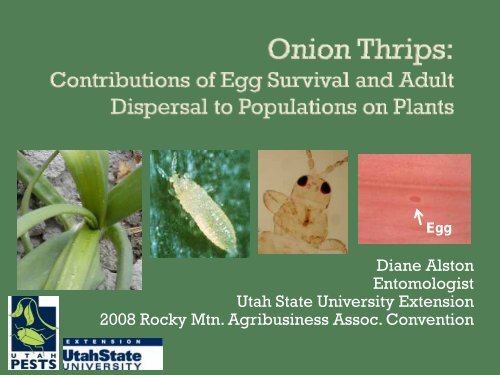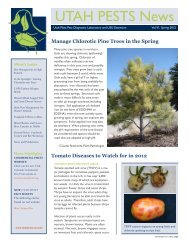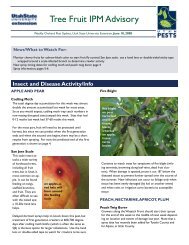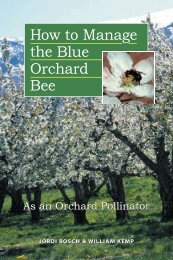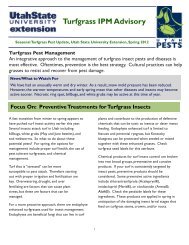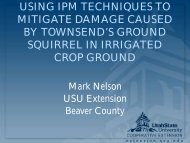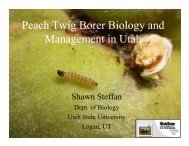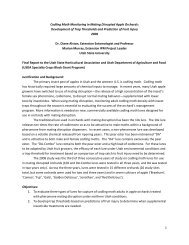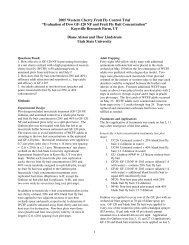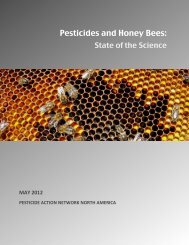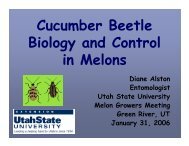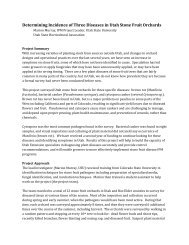Onion Thrips - Utah Pests - Utah State University
Onion Thrips - Utah Pests - Utah State University
Onion Thrips - Utah Pests - Utah State University
You also want an ePaper? Increase the reach of your titles
YUMPU automatically turns print PDFs into web optimized ePapers that Google loves.
Egg<br />
Diane Alston<br />
Entomologist<br />
<strong>Utah</strong> <strong>State</strong> <strong>University</strong> Extension<br />
2008 Rocky Mtn. Agribusiness Assoc. Convention
Life history and ecology are<br />
well-adapted to onions<br />
• Females reproduce asexually<br />
(parthenogenesis)<br />
• Short generation time (2-3 wk)<br />
• High mobility of adults<br />
• Rapid development of resistance<br />
to insecticides<br />
• Life stage survival strategies<br />
• Later larval instars are non-feeding &<br />
protected (“prepupae” & “pupae”)<br />
• Eggs are protected – females insert<br />
them into leaf tissue<br />
<strong>Thrips</strong> life stages
Adults<br />
Eggs,<br />
Larvae,<br />
& Adults<br />
Prepupae<br />
& Pupae
1. Whole plant 2. Stain 3 rd 3. Aerial sticky<br />
wash leaf traps<br />
Larva<br />
Adult<br />
Egg<br />
Adult
Examples from 2006 & 07 insecticide trials<br />
USU Experiment Station, Kaysville, UT
<strong>Thrips</strong> sampling tools<br />
1. Whole plant<br />
wash<br />
Larva<br />
Adult
Insecticide efficacy<br />
Motile thrips ps( (Adults and Larvae)<br />
July, 2006<br />
Mea an # of thrips per pla ant<br />
*<br />
Days after treatment<br />
*<br />
1% Stylet oil added to Success, Carzol, and Warrior treatments
Insecticide efficacy<br />
Adult <strong>Onion</strong> <strong>Thrips</strong> (<strong>Thrips</strong> p tabaci) )<br />
July, 2007<br />
Mean # of thri ips per plant<br />
*<br />
In an August trial, NS differences among treatments
Insecticide efficacy<br />
Adult Western Flower <strong>Thrips</strong> (Frankliniella occidentalis) )<br />
July, 2007<br />
Mean # of thri ips per plant<br />
* *<br />
*
Insecticide efficacy<br />
<strong>Thrips</strong> Larvae<br />
July, 2007<br />
Mean # of thri ips per plant<br />
*<br />
* *<br />
Similar results in an August trial
In 2006:<br />
• Success, Carzol, and Warrior effectively<br />
suppressed adults & larvae for 14 days<br />
• Surround & 2% Stylet t oil slowed thrips for 7 days<br />
In 2007:<br />
• Adult OTs were minimally affected<br />
• Adult WFTs densities were 10-100X less than<br />
OTs & a number of insecticides suppressed<br />
WFTs for 14 days<br />
• Vydate, Carzol, Lannate, Radiant, Warrior<br />
Adults may escape whole plant wash method
In 2007:<br />
• Lannate & Radiant most consistently suppressed<br />
larvae (2 trials)<br />
• Movento showed delayed effects of 2-3 wks<br />
• Systemic - delay in uptake & translocation within<br />
plant<br />
• Vydate, Carzol, & Warrior performed better in an<br />
August trial (data not shown), but not as well as<br />
Lannate, Radiant, and Movento<br />
Insecticide resistance (Warrior, Carzol)<br />
after 2-3 yrs of use
Examples from 2006 & 07 insecticide trials<br />
USU Experiment Station, Kaysville, UT
<strong>Thrips</strong> sampling tools<br />
2. Stain 3 rd<br />
leaf<br />
Egg
Effect of immobile life stages<br />
on plant thrips populations<br />
Reduce<br />
re-infestation<br />
of plants<br />
Eggs,<br />
Larvae,<br />
& Adults<br />
Prepupae<br />
& Pupae<br />
Adults
Insecticide efficacy<br />
<strong>Thrips</strong> Eggs (Stained within leaves)<br />
July, 2007<br />
Mean<br />
# of eg ggs per le eaf<br />
*
Insecticide efficacy<br />
<strong>Thrips</strong> Eggs (Stained within leaves)<br />
August, 2007<br />
Mean<br />
# of eg ggs per le eaf<br />
*
Life stage on plant<br />
% composition of total<br />
population<br />
Eggs in leaves 60-75%<br />
Larvae in neck 15-30%<br />
Adults in neck 1-3%*<br />
*Adults are likely under-represented in whole plant wash samples
Egg hatch from leaves<br />
Egg hatching chamber<br />
• Heavy-duty gallon-sized ziplock<br />
plastic bags<br />
• Collect onion leaves (3 rd leaf)<br />
from field plants 1, 2, & 3 wk after<br />
insecticide treatment (8 leaves<br />
per treatment)<br />
• Wash leaves & place in hatching<br />
chamber with moist filter paper<br />
• Placed at 25°C for 2 wk<br />
• Wash to collect thrips from leaf &<br />
inside of bag at 1 & 2 wk<br />
High-tech thrips<br />
hatching chamber
Insecticide efficacy<br />
<strong>Thrips</strong> egg hatch (over 2 wk)<br />
July, 2007<br />
f per leaf<br />
Mean # of<br />
hatched<br />
thrips<br />
*<br />
* *<br />
Results from an August trial were similar
er leaf<br />
thrips pe<br />
hatched t<br />
an # of h<br />
Mea<br />
Influence of insecticides on rate of thrips egg hatch –<br />
2 weeks after treatment, t t July 10, 2007<br />
Week 1 > Week 2: p < 0.001<br />
Trt x Week interaction: p = 0.007
er leaf<br />
thrips pe<br />
hatched t<br />
an # of h<br />
Mea<br />
Influence of insecticides on rate of thrips egg hatch –<br />
3 weeks after treatment, t t July 17, 2007<br />
Week 1 > Week 2: p < 0.001
Eggs are the major contributor to<br />
populations on plants (60-75%)<br />
• Eggs abundant in leaves (13-112112 per 3 rd leaf)<br />
• Previous study: total eggs per plant ≈ 3× 3 rd leaf<br />
Insecticides had little effect on numbers<br />
of eggs within leaves<br />
• Similar to minimal effects on adult OTs
Some insecticides suppressed egg hatch<br />
up to 3 wk (4-5 wk):<br />
• Lannate & Movento (+ MSO) – greatest<br />
reductions; kept hatch < 14 thrips per leaf<br />
• 1-54 eggs hatched per leaf across 2 trials<br />
Most eggs hatched within 1 week<br />
Future studies: Larger sample sizes<br />
needed (8 leaves)
Examples from 2006 & 07 insecticide trials<br />
USU Experiment Station, Kaysville, UT
<strong>Thrips</strong> survival on plants<br />
vs. immigrationi i<br />
Immediately after<br />
insecticides were applied:<br />
• Open plants (allow immigration<br />
& natural enemies)<br />
• Spray with soap and Caged plants<br />
(remove motile stages &<br />
exclude immigrants & NEs)<br />
PVC pipe collar
Importance of egg survival<br />
Influence of exclusion (caging) on onion thrips<br />
populations p on plants 2 wk after insecticides<br />
2006<br />
E i l<br />
Egg survival<br />
was more<br />
important<br />
than new<br />
immigrants
Influence of exclusion (caging) on onion thrips densities<br />
(adults and larvae) on plants 2 wks after treatment<br />
July 10, 2007<br />
lant<br />
ps per pl<br />
# of thrip<br />
Mean #<br />
Open is not different from Caged: p = 0.86<br />
Presence of cage X insecticide interaction: p = 0.007
Influence of exclusion (caging) on onion thrips densities<br />
(adults and larvae) on plants 3 wks after treatment<br />
July 17, 2007<br />
lant<br />
ps per pl<br />
# of thrip<br />
Mean #<br />
Caged > Open: p = 0.05
<strong>Thrips</strong> sampling tools<br />
3. Aerial sticky<br />
traps<br />
Adult
Abundance of Immigrating Adults<br />
Influence of insecticides on thrips adult<br />
dispersal: before compared to after insecticides<br />
2006<br />
rips per tra ap per wee ek<br />
of adult thr<br />
Mean # o<br />
* *<br />
*<br />
*<br />
1% Stylet oil added to Success, Carzol, and Warrior treatments
In general, more thrips occurred on<br />
caged than open plants 2-3 wk after<br />
treatment<br />
• Egg reservoir in leaves is important to reinfestation<br />
of plant<br />
• Exceptions: Lannate, Movento, & Radiant –<br />
longer-term suppression of thrips on plants<br />
Flying thrips adults: highly abundant<br />
• ~ 150-300 adults per trap per week after<br />
insecticide id applications
Egg survival and immigrating adults<br />
following insecticide applications help<br />
perpetuate thrips population on onions<br />
Suppression strategies: include<br />
prevention of egg-laying and egg hatch<br />
Future studies:<br />
• Larger sample sizes (improve consistency)<br />
• Evaluate survival of non-feeding 3 rd and 4 th<br />
instar larvae (pre-pupae p p & pupae) p
<strong>Onion</strong> thrips life history<br />
Reduce/repel<br />
dispersing adults<br />
Reduce<br />
re-infestation<br />
of plants<br />
Eggs,<br />
Larvae,<br />
& Adults<br />
Prepupae<br />
& Pupae<br />
Adults<br />
Egg-laying<br />
Egg hatch
Mortality factor (insecticide):<br />
• Short-term quick knock-down of adults &<br />
larvae<br />
• Longer-term egg reservoir in leaves (2 wk)<br />
• Longer-term immigration of adults<br />
• Longer-term survival of pre-pupae & pupae
Sustained<br />
Mortality /<br />
Repellency<br />
Cultural practices:<br />
- Sprinkler irrigation<br />
- Varietal tolerance<br />
-Mulches<br />
-Trap crops<br />
- Nitrogen management<br />
Insecticides:<br />
- Manage use to prevent<br />
resistance<br />
- Systemic activity<br />
- Slow release (microencap)<br />
- Ovicide, larvicide,<br />
adulticide<br />
-Repellents<br />
- Combinations
Make onions as<br />
tolerant / unattractive<br />
to thrips as possible<br />
Start suppression early<br />
in the season<br />
Use long-term<br />
Morgan Reeder field on 2006<br />
suppressive controls<br />
• Target egg reservoir in<br />
leaves<br />
• Target multiple life stages<br />
<strong>Utah</strong> <strong>Onion</strong> Tour, Corinne, UT


